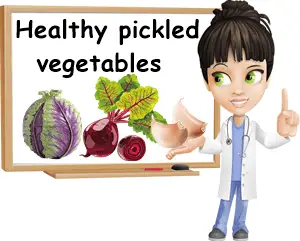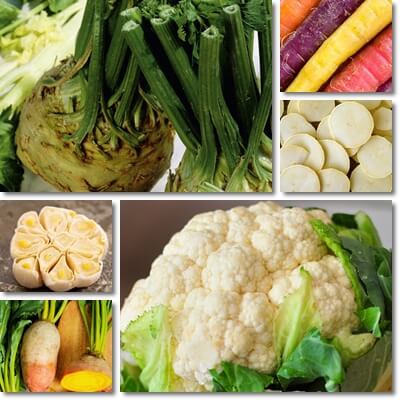What are some healthy vegetables that you can pickle? It’s time to get over gherkins, which are fruits anyway, and consider some even healthier vegetables to pickle, such as beets, parsnip and even celeriac, or celery root. These 10 vegetables below are some of the healthiest foods that you can pickle, and readily available too. Enjoy them by themselves, as they are or cooked, or mix and match to create an assortment of pickles that is sure to impress.
Artichoke hearts
Artichokes are one of the best vegetables you can pickle. Clean the artichokes of leaves and blanch and marinate the artichoke hearts with herbs, salt, crushed pepper, extravirgin olive oil and white wine vinegar. Artichokes are good for lowering cholesterol because they help the body process cholesterol more effectively, and prevent cholesterol deposits on artery walls at the same time. Artichokes also provide hepatoprotective benefits, supporting bile production and regeneration of liver cells.
Also see the benefits of artichoke tea.

Beetroot
Beets are a classic pickled vegetable and one of the best tasting, with pleasant, sweet, earthy flavors and a very complimenting acetous sharpness. Roast your beets, whole, sliced or cut in stripes of cubes, and marinate with water, sugar, vinegar and a bit of oil. Both red and yellow beetroot contain pigmented betalain antioxidants: betacyanins such as betanin in red beets and betaxanthins in yellow beets, with scientifically proven anticancer properties and benefits for lowering blood pressure.
Interesting facts: eating too many red beets, pickled or not, can cause urine and stools to temporarily turn pink, red or maroon, mimicking the presence of blood.
Discover what are some other foods that color stools.
Cabbage
Blanch white or green cabbage leaves and roll tightly one around the other until you fill up a jar and marinate with peppercorns, dill, salt, water and vinegar to use later on in the winter for stuffed cabbage rolls. Or cut julienne red or purple cabbage, aka cut into thin shreds, pair with some orange carrots for great color coordination, and pickle together. All cabbage colors contain organic sulfur compounds as well as anthocyanin antioxidants, both with scientifically proven anticancer properties.
Carrots
Cut your carrots in thin strips, grate or cube and make a classic pickled vegetable. Choose orange carrots for their high content of beta-carotene with benefits for vision and immune system support. Choose yellow carrots for their high content of yellow xanthophyll antioxidants that contribute to the physical health of the retina of the eyes. Choose red carrots which are high in lycopene with blood pressure lowering properties and benefits for atherosclerosis prevention. Or choose purple carrots or black carrots high in anthocyanins with anticancer properties.

Cauliflower
Cauliflower is one of the best foods you can pickle: it’s both healthy and retains a pleasant crunchy texture that is sure to be a family favorite. Cauliflower is a source of organic sulfur compounds such as isothiocyanates and glucosinolates with anticancer properties. Pair with bay leaves and carrot slices of different colors for cool looking pickles, rose pepper and fennel seeds, slices of red Romanian Gogosari peppers, or simply color with turmeric. And avoid boiling the cauliflower beforehand to prevent the loss of its bioactive components (instead just cut in into thinner pieces).
Celeriac
Celeriac is a root vegetable, celery root actually. Celeriac is rather bland tasting – boiled celeriac makes for a great substitute for mashed potatoes. But roasting and pickling your celeriac just gives it new dimensions in terms of flavor. Celeriac is extremely nutritious, and a source of polyacetylenes which studies found to display toxic effects against various types of cancer, including colon cancer and acute lymphoblastic leukemia. A word of caution though: celeriac is a common allergen, just as common as celery.
Garlic
Garlic is just delicious: raw, crushed, boiled, fried and even pickled. Garlic can be pickled for use as a condiment, in small amounts for flavoring various dishes, or as a vegetable that you can eat in small amounts as the pickling process takes some of its pungency away. Pickled garlic makes for a healthy prebiotic food that helps promote gut health by feeding good gut bacteria populations. See what happens when you eat garlic on an empty stomach. You can also pickle red garlic, not just white.
Mushrooms
Mushrooms can be pickled successfully in water with oil and a little vinegar. You can pickle the more common portobello mushrooms, smaller button mushrooms and even more appetizing varieties such as oyster mushrooms and chanterelles. You’ll get a prebiotic and probiotic food with benefits for gut health, and a source of vitamin D2 and other bioactive components with benefits for blood pressure, blood cholesterol and even thyroid health.
Onions
Onions are one of the best things to pickle. You can pickle white, yellow or red onions, and you can pickle them together with other vegetables such as roasted and peeled Kapia peppers in oil. The pickling process will reduce the pungency of the onions and turn them into a low-calorie prebiotic and probiotic food that supports gut health.
Parsnip
Parsnip is a great food to pickle and an important dietary source of B vitamins, notably vitamins B1, B5, B6 and B9, as well as a good source of potassium and magnesium for blood pressure control and phosphorus for strong bones and teeth. Parsnip also contains falcarinol and falcarindiol, two natural antioxidants with anticancer properties. Because it is high in vitamin K which is a fat soluble vitamin, parsnip is best pickled in at least some amount of vegetable oil to boost absorption.
